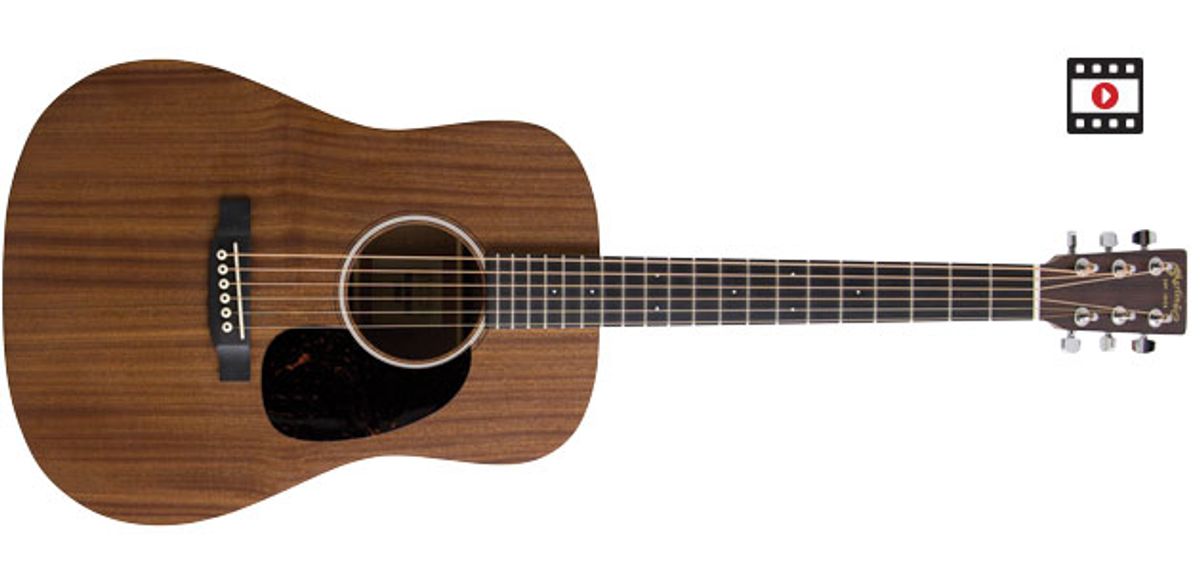Martin shrinks its signature body shape, upending expectations of what a travel guitar can deliver.
Little guitars—or at least those small enough to fit in an airliner overhead compartment or on your back for a bike ride down a country lane—are nothing new. Parlor guitars, for instance, have been around for more than a century. But it was Martin that really popularized the notion of a “travel guitar” with their diminutive, paddle-shaped Backpacker model.
Since then, a lot of builders have tried to make travel guitars a lot more traditionally guitar-like (often at the expense of their travel-worthiness). But while the Martin D Jr. might push the boundaries of what’s a travel guitar and what’s just small, it’s still diminutive and light enough to strap onto your back for a bike ride or take aboard a 737. And in this new, all-solid sapele guise, it also upends many expectations of what a travel guitar can deliver in sonic terms.
Baby Battleship
I’m an absolute sucker for Martin’s small-body, all-mahogany 15 and 17 Series instruments—not just for the warm and toasty sounds and relative economy, but for how completely understated, classy, and no-nonsense tough they look. The all-sapele D Jr. achieves the same effect. (Sapele, incidentally, is closely related to mahogany both sonically and visually and has been used occasionally for the back and sides in the 15-series instruments.)
Fit and finish, with very few exceptions, are the top-flight stuff we’re used to from Martin. And though the Junior’s point of origin is the company’s Mexico facility rather than the hallowed halls of Nazareth, there’s no let-up in attention to detail: Joints, fretwork, binding, and bracing are all flawless. That said, there are a few critical differences in the materials used in the D Jr. and those you’d see on, say, a 000-15 from Pennsylvania. The sapele top features some odd figuring that would probably never make the cut on a 15-Series guitar. Does a little irregularity in the grain affect the sound? Clearly not, as we’ll find out. It’s also doubtful every sapele Junior features this kind of irregularity. But there is something just a little un-Martin about how this particular specimen looks at a glance. Elsewhere the sapele beams with a warm, chocolaty glow. Even the Richlite bridge and fretboard stand in nicely for ebony and rosewood.
Booming Beyond Its Weight Class
The Dreadnought Junior has a way of making you forget classifications like “travel guitar,” and any biases associated with the term, very quickly. It’s a good sounding little guitar by any standard. The first thing you notice is an outsize bass presence that can be a touch startling if you haven’t already abandoned those small-guitar prejudices. The low end is big, resonant, and colorful with overtones that shine, thanks to the equally impressive sustain. Those qualities are even more pronounced when the guitar is tuned down to D and C—environments where it fares exceptionally well. If such pronounced and complex thump is unusual for the guitar’s size and short 24" scale, it’s also a very welcome (and well-integrated) counterpoint to the Jr’s very focused mid-centric fundamental voice.
Ratings
Pros:
Big, resonant, and colorful bass tones that work well with tight, focused midrange. Nice build quality. Unique voice. Sounds much bigger than your typical “travel” guitar.
Cons:
Midrange can sound a bit boxy.
Tones:
Playability:
Build/Design:
Value:
Street:
$609
C.F. Martin & Co. D Jr.
martinguitar.com
For players accustomed to close sonic similarities between sapele and mahogany instruments, this aspect of the Jr.’s tone profile may also surprise. There’s less of the bloom and warm, fuzzy, patina’d glow around the edges than I’m used to in all-mahogany Martins. It’s a sound that many would classify as “contemporary,” and it can probably be chalked up, in part, to the guitar’s newness. But what the midrange might lack in complexity or character it makes up for by seamlessly integrating with the delicious low end—lending definition to fingerpicked patterns and presence to chord strumming.
The 24" scale shapes the playing experience in more than audible ways. It also makes the Junior feel relatively slinky and easy to play—which is remarkable considering how high the action on our test guitar was. A little saddle shave would probably go a long way toward making the guitar feel faster still. As is, the high-ish action makes the guitar positively ring. The short scale also feels less cramped thanks to the 1 3/4" nut width. And while the Jr. will never encourage fleet-fingered shredding much past the 7th fret, it feels spacious enough for deep bends, slides, hammer-ons, and pull-offs through the first five frets.
The Fishman Sonitone electronics and the soundhole-mounted preamp are a nice addition, though the system can be less than flattering to the guitar’s midrange at higher volumes and doesn’t very easily communicate the integration of low end and midrange that’s a highlight of the instrument’s acoustic voice. For a guitar at this price, however it’s a cool additional asset and will work well in most performance situations—particularly if you have a nice D.I. with effective EQ-shaping functions.
The Verdict Apart from a comparatively boxy midrange (which isn’t entirely a bad thing), there are few ways that the Dreadnought Junior feels like anything other than a real grown-up acoustic. And while portability might be the primary reason for its existence, it’s full of the potential to be a unique recording studio asset and a great creative companion that can hold its own with more conventional and classic flattops.
Watch the Review Demo:


